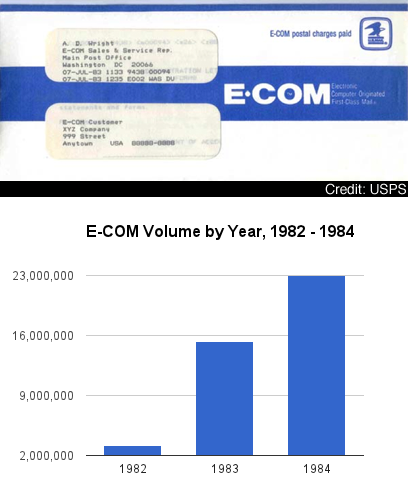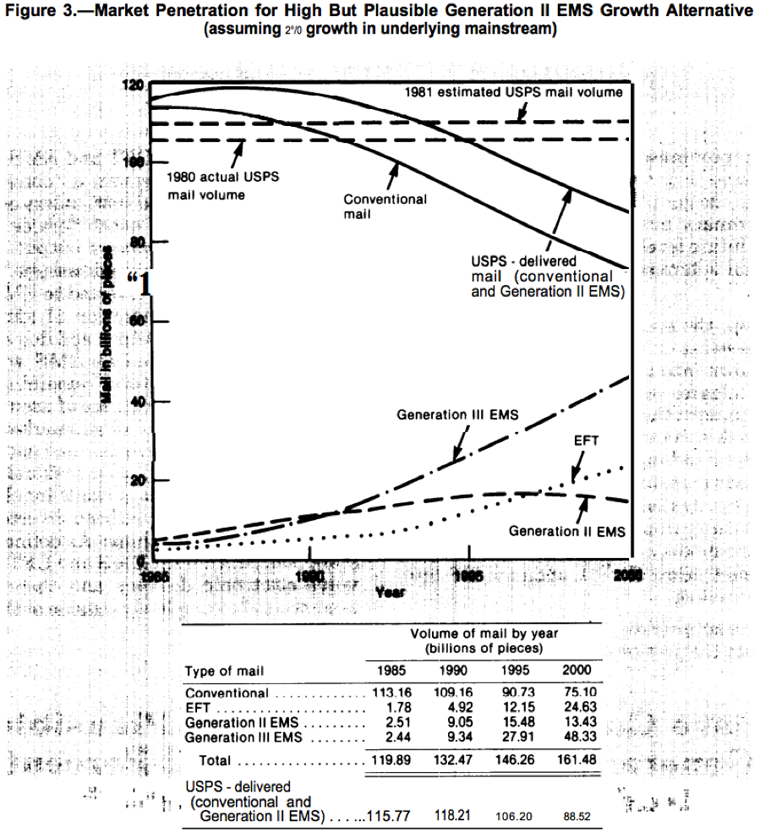The Postal Service’s 30-Year Relationship with Email
The federal government, a key innovator in the early years of computing, knew at least 30 years ago that email was going to disrupt the United States Postal Service (USPS).
In a 1982 report, “Implications of Electronic Mail and Message Systems for the U.S. Postal Service,” the now-defunct Office of Technology Assessment (OTA) examined the electronic messaging marketplace and made recommendations for Congress and the USPS. The report stated the following:
Changes are taking place so fast in the so-called “communications revolution” that by the time USPS actually experienced significant reductions in conventional mail volume, most opportunities for participation in [electronic mail and message systems] would have passed and it would be much more difficult to adjust.
It seems clear that two-thirds or more of the mainstream could be handled electronically, and that the volume of mail is likely to peak in the next 10 years and fall below today’s level sometime in the 1990’s.
The prediction was accurate, but the timeline wasn’t. As the chart below illustrates, mail volume in 2012 was actually higher than in 1982 and First Class mail volume peaked in 2001 (although total mail volume peaked in 2006).
There was time to react. So what happened?
The Post Office Flirted with Email in 1982

In our "History of Email in the Federal Government," we noted that the USPS actually made a real effort at tackling email in the late 1970s and early 1980s: “Known as E-COM, the program allowed users to send electronic mail to a post office branch. From there, it was printed and hand-delivered.” The system was active from 1982 to 1985, but it faced hurdles from the beginning. The Justice Department was concerned that the E-COM program violated antitrust laws, leading potential customers to believe the service would be short lived. Federal laws prevented the USPS from subsidizing the cost of services with funds from other services, making the program too expensive to gain traction. In addition, there was a 200-message minimum on each transaction, and letters could be no longer than two pages.
The initiative was far from profitable. In 1985, the Cato Institute reported that “the service charged 26 [cents] a letter and lost $5.25 a letter.” Still, the postal service knew that prices had to be low in order to compete. The Postal Rate Commission, a federal regulatory agency, refused to lower rates and effectively “priced E-COM out the market,” according to the USPS. The OTA’s report suggested that the “communications marketplace will significantly affect USPS finances, service levels, and labor force requirements” and that it would be “prudent for Congress and USPS to address these issues aggressively.” Despite growing volume and evidence of the rise of electronic communication, the program was discontinued in 1985.
A First-Class Identity Crisis

The chart above is the OTA’s prediction for the growth of Generation II (“electronic input and transmission with hardcopy output”) and Generation III (“all-electronic”) electronic communication compared with the traditional mail volume. It was clear to the post office that First Class mail volume would be dropping significantly in the coming years, and even Generation II — E-COM falls into this category — was not expected to compete with all-electronic communication by 1995.
In 2000, the USPS launched Post Electronic Courier Service (PosteCS), which allowed “customers to create and send messages via the Internet through a postal account and the USPS data center,” according to FCW. Electronic documents were stored on a USPS server, and users were notified about the message on their personal email account. The service cost $1.70 per message but was discontinued in 2002.
"E-mail is not a threat. (Postal mail) is universal. The Internet is not."
Susan Brennan, USPS
"E-mail is not a threat,” said USPS spokesperson Susan Brennan in a 2001 Wired article. “(Postal mail) is universal. The Internet is not.” At the time, mail volume was at an all-time high, and some questioned the OTA’s 20-year-old report, which had predicted that mail volume would peak in the early 1990s. Her prognostication could not have been more wrong. Within 10 years, First Class mail volume had dropped more than 30 percent.
While the USPS has always been a high-tech organization — sorting and delivering millions of pieces of mail per day requires complex systems — its ventures into electronic messaging have not been successful. What does the future hold? Mohammad Adra, head of the USPS’s Risk Analysis Research Center, believes the future could be bright, according to a recent Esquire article:
The point of the post office was never paper, or even simply mail, he says. It was binding the nation together — connecting people. So what he and his twenty-person team do in their cubicles and workrooms, surrounded by papers with titles like “The Cost Structure of the Postal Service: Facts, Trends, and Policy Implications,” is study how the postal service might best fulfill that goal in the digital world.
In addition to digital-only services, such as government-issued email addresses, Adra believes the postal service should play to its strength: delivering physical mail. By leveraging physical infrastructure — trucks, routes, carriers, etc. — the USPS is uniquely positioned to handle e-commerce delivery and could play a key role in same-day delivery services. As always, success will depend on whether the USPS can move to implement services before a more nimble, private company does.
How do you think the USPS should handle digital communications, if at all? Let us know in the Comments section.








